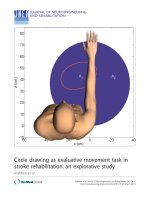Báo cáo hóa học: " FIXED POINTS AS NASH EQUILIBRIA" doc
Bạn đang xem bản rút gọn của tài liệu. Xem và tải ngay bản đầy đủ của tài liệu tại đây (463.01 KB, 4 trang )
FIXED POINTS AS NASH EQUILIBRIA
JUAN PABLO TORRES-MART
´
INEZ
Received 27 March 2006; Re vised 19 September 2006; Accepted 1 October 2006
The existence of fixed points for single or multivalued mappings is obtained as a corollar y
of Nash equilibrium existence in finitely many players games.
Copyright © 2006 Juan Pablo Torres-Mart
´
ınez. This is an open access article distributed
under the Creative Commons Attribution License, which permits unrestricted use, dis-
tribution, and reproduction in any medium, provided the original work is properly cited.
1. Introduction
In game theory, the existence of equilibrium was uniformly obtained by the application
of a fixed point theorem. In fact, Nash [3, 4] shows the existence of equilibria for nonco-
operative static games as a direct consequence of Brouwer [1] or Kakutani [2] theorems.
More precisely, under some regularity conditions, given a game, there always exists a cor-
respondence whose fixed points coincide with the equilibrium points of the game.
However, it is natural to ask whether fixed points arguments are in fact necessary
tools to guarantee the Nash equilibrium existence. (In this direction, Zhao [5] shows
the equivalence between Nash equilibrium existence theorem and Kakutani (or Brouwer)
fixed point theorem in an indirect way. However, as he points out, a constructive proof is
preferable. In fact, any pair of logical sentences A and B that are true will be equivalent
(in an indirect way). For instance, to show that A implies B it is sufficienttorepeatthe
proof of B.) For this reason, we study conditions to assure that fixed points of a continu-
ous function, or of a closed-graph correspondence, can be attained as Nash equilibria of
a noncooperative game.
2. Definitions
Let Y
⊂ R
n
be a convex set. A function v : Y → R is quasiconcave if, for each λ ∈ (0,1),
we have v(λy
1
+(1− λ)y
2
) ≥ min{v(y
1
),v(y
2
)},forall(y
1
, y
2
) ∈ Y × Y .Moreover,iffor
each pair (y
1
, y
2
) ∈ Y × Y such that y
1
= y
2
the inequality above is strict, independently
of the value of λ
∈ (0,1), we say that v is strictly quasiconcave.
Hindawi Publishing Corporation
Fixed Point Theory and Applications
Volume 2006, Article ID 36135, Pages 1–4
DOI 10.1155/FPTA/2006/36135
2 Fixed points as Nash equilibria
Amapping f : X
⊂ R
m
→ X has a fixed point if there is x ∈ X such that f (x) = x.A
vector
x ∈ X is a fixed point of a correspondence Φ : X X if x ∈ Φ(x).
Given a game Ᏻ
={I,S
i
,v
i
}, in which each player i ∈ I ={1,2, ,n} is characterized
by a set of strategies S
i
⊂ R
n
i
, and by an objective function v
i
:
n
j
=1
S
j
→ R,aNash equi-
librium is a vector
s = (s
1
,s
2
, ,s
n
) ∈ Π
n
i
=1
S
i
,suchthatv
i
(s) ≥ v
i
(s
i
,s
−i
), for all s
i
∈ S
i
,for
all i
∈ I,wheres
−i
= (s
1
, ,s
i−1
,s
i+1
, ,s
n
).
Finally, let Ᏼ
={S : ∃n ∈ N, S ⊂ R
n
is nonempty, convex, and compact}.
3. Main Results
Consider the following statements.
[Nash-1]. Given Ᏻ
={I,S
i
,v
i
}, suppose that each set S
i
∈ Ᏼ and that objective functions
are continuous in its domains and st rictly quasiconcave in its own strategy. Then there is
a Nash equilibrium for Ᏻ.
[Nash-2]. Given Ᏻ
={I,S
i
,v
i
}, suppose that each set S
i
∈ Ᏼ and that objective functions
are continuous in its domains and quasiconcave in its own strategy. Then there is a Nash
equilibrium for Ᏻ.
[Brouwer]. Given X
∈ Ᏼ, ever y continuous function f : X → X has a fixed point.
[Kakutani
∗
]. Given X ∈ Ᏼ, every closed-graph correspondence Φ : X X,withΦ(x) ∈
Ᏼ for all x ∈ X, has a fixed point, provided that Φ(x) =
m
j
=1
π
m
j
(Φ(x)) for each x ∈ X ⊂
R
m
.(Foreachj ∈{1, ,m},theprojectionsπ
m
j
: R
m
→ R are defined by π
m
j
(x) = x
j
,
where x
= (x
1
, ,x
m
) ∈ R
m
.) (The last property, Φ(x) =
m
j
=1
π
m
j
(Φ(x)), is not necessary
to assure the existence of a fixed p oint, provided that the other assumptions hold. How-
ever, when objective functions are quasiconcave, [Kakutani
∗
]issufficient to assure the
existence of a Nash equilibrium.)
Our results are [Nash-1]
→ [Brouwer].
Proof. Given a nonempty, convex, and compact set X
⊂ R
m
and a continuous function
f : X
→ X, consider a game Ᏻ with two players I ={A,B}, which are characterized by the
sets of stra tegies S
A
= S
B
= X and by the objective functions: v
A
(x
A
,x
B
) =−x
A
− x
B
2
and v
B
(x
A
,x
B
) =−f (x
A
) − x
B
2
,where·denotes the Euclidean norm in R
m
.
As objective functions are continuous in S
A
× S
B
and strictly quasiconcave in own
strategy, there exists a Nash equilibrium (
x
A
,x
B
). Moreover, x
A
= x
B
and x
B
= f (x
A
),
that assure the existence of a fixed point of f : X
→ X.
In fact, if
x
A
= x
B
,thenv
A
(x
A
,x
B
) < 0. Thus, player A can improve his gains choosing
a response x
A
= x
B
∈ X,asv
A
(x
B
,x
B
) = 0, a contradiction. Analogous arguments prove
that
x
B
= f (x
A
) because f (x
A
) ∈ X.
We have [Nash-2]
→ [Kakutani
∗
].
Proof. Fix a set X ⊂ Ᏼ and a correspondence Φ : X X that satisfies the assumptions
of [Kakutani
∗
]. Define, for each 1 ≤ i ≤ m, the functions κ
m
i
: R
m
× R
m
→ R
m
× R by
κ
m
i
(x, y) = (x, y
i
), where y = (y
1
, , y
m
) ∈ R
m
.
Juan Pablo Torres-Mart
´
ınez 3
Consider a game Ᏻ with m+1players,
{0,1, ,m}, characterized by the sets of strate-
gies (S
0
,(S
i
; i>0)) := (X,(π
m
i
(X); i>0)) and by the objective functions: v
0
(x
0
,x
−0
) =
−
x
0
− x
−0
2
, v
i
(x
0
,x
1
, ,x
m
) =−min
(r,s
i
)∈κ
m
i
(Gr[Φ])
(x
0
,x
i
) − (r,s
i
)
max
,whereGr[Φ]
denotes the graph of Φ,
·
max
is the max-norm, and x
−0
:= (x
1
, ,x
m
).
As hypotheses of [Nash-2] hold (see the appendix), there is an equilibrium (
x
0
;
(
x
1
, ,x
m
)) for Ᏻ. It follows that x
i
∈ π
m
i
(Φ(x
0
))(If x
i
/∈ π
m
i
(Φ(x
0
)) then, by defini-
tion, (
x
0
,x
i
) /∈ κ
m
i
(Gr[Φ]). Thus, player i’s utility, v
i
(x
0
,x
1
, ,x
m
) < 0. However, choos-
ing any x
i
∈ π
m
i
(Φ(x
0
)) =∅,theplayeri can improve his gains, as (x
0
,x
i
) ∈ κ
m
i
(Gr[Φ])
and, therefore, his utility will be equal to zero, a contradiction.) Therefore, by Assump-
tion [Kakutani
∗
], (x
1
, ,x
m
) ∈ Φ(x
0
). Finally, x
0
= (x
1
, ,x
m
) ∈ Φ(x
0
)(If x
0
= x
−0
:=
(x
1
, ,x
n
), we have that v
0
(x
0
,x
−0
):=−x
0
− x
−0
2
< 0. Thus, player 0 can improve his
position choosing x
0
= x
−0
∈ X.) That concludes the proof.
Appendix
It follows from definitions above that the sets of strategies satisfy the assumptions of
[Nash-2], objective functions are continuous and v
0
is quasiconcave in it own strategy.
Thus, rest to assure that functions v
i
,withi ≥ 1, are quasiconcave in its own strategy.
This will be a direct consequence of the following lemma, taking Z
= κ
m
i
(Gr[Φ]).
Given x
∈ R
m+1
and a nonempty set Z ⊂ R
m+1
, the distance from x to Z is d(x,Z) =
inf
z∈Z
x − z
max
. Note that the function x → d(x,Z) is continuous, because |d(x
1
,Z) −
d(x
2
,Z)|≤x
1
− x
2
max
. For convenience of notations, let π : R
m
× R → R
m
be the pro-
jection defined by π(x, y)
= x.
Lemma A.1. Suppose that Z
⊂ R
m+1
is a nonempty and compact set such that, for each
x
∈ R
m
,bothπ(Z) and Z ∩ π
−1
(x) are convex sets. Then the funct ion f : R
m
× R → R
defined by f (x,t) = d((x, t),Z) is quasiconvex in t.
Proof. Fix a vector x
0
∈ R
m
. We have to show that L
c
={t ∈ R; d((x
0
,t), Z) ≤ c} is a
convex set for every c
≥ 0. Assume by contradiction that, given c ≥ 0, there are scalars
t
1
<t
∗
<t
2
such that t
1
,t
2
∈ L
c
and t
∗
∈ L
c
.LetA :={x ∈ π(Z); x − x
0
max
≤ c} and
consider the following sets:
A
1
={x ∈ A; ∃t ∈ R s.t. (x, t) ∈ Z, t ≤ t
∗
− c};
A
2
={x ∈ A; ∃t ∈ R s.t. (x, t) ∈ Z, t ≥ t
∗
+ c}.
(A.1)
Since d((x
0
,t
∗
),Z) >c,wehaveA = A
1
∪ A
2
.Moreover,A
1
∩ A
2
=∅. (If there exists a
vector x
∈ A
1
∩ A
2
,thenx − x
0
max
≤ c and, by the convexity of Z ∩ π
−1
(x), (x,t
∗
) ∈ Z,
contradicting d((x
0
,t
∗
),Z) >c.) Since Z is compact, A
1
and A
2
are compact as well. And
since π(Z) is convex, so is A.Inparticular,A is connected. Therefore, A
1
=∅or A
2
=∅.
On the other hand, d((x
0
,t
1
),Z) ≤ c, so there exists a point (x
,t
) ∈ Zc-close to
(x
0
,t
1
). Then x
− x
0
max
≤ c and t
≤ t
1
+ c<t
∗
+ c, therefore x
∈ A \ A
2
, proving that
A
1
=∅. Analogously, it follows from d((x
0
,t
2
),Z) ≤ c that A
2
=∅.Wehaveobtaineda
contradiction.
4 Fixed points as Nash equilibria
Acknowledgments
I am indebted with Jairo Bochi for useful suggestions and comments. I also would like to
thank the suggestions of Carlos Herv
´
es-Beloso, Alexandre Belloni, and Eduardo Loyo.
References
[1] L.E.J.Brouwer,
¨
Uber Abbildung von Mannigfaltigkeiten, Mathematische Annalen 71 (1912),
no. 4, 598.
[2] S. Kakutani, A generalization of Brouwer’s fixed point theorem, Duke Mathematical Journal 8
(1941), no. 3, 457–459.
[3] J. F. Nash, Equilibrium points in n-person games, Proceedings of the National Academy of Sci-
ences of the United States of America 36 (1950), no. 1, 48–49.
[4]
, Non-cooperative games, Annals of Mathematics. Second Series 54 (1951), 286–295.
[5] J. Zhao, The equivalence between four economic theorems and Brouwer’s fixed point theorem,
Working Paper, Departament of Economics, Iowa State University, Iowa, 2002.
Juan Pablo Torres-Mart
´
ınez: Department of Economics, Pontif
´
ıcia Universidade Cat
´
olica do Rio de
Janeiro (PUC-Rio), Marqu
ˆ
es de S
˜
ao Vicente 225, Rio de Janeiro 22453-900, Brazil
E-mail address: jptorres









